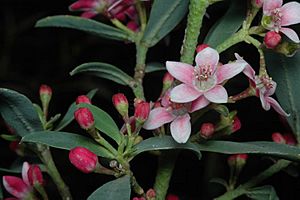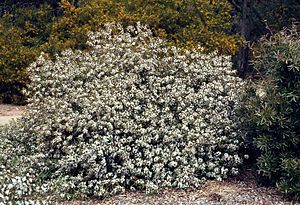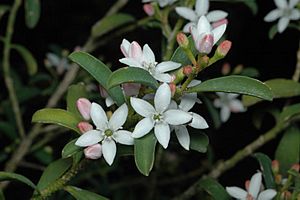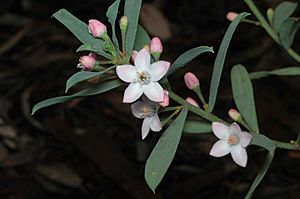Long-leaf wax flower facts for kids
Quick facts for kids Long-leaf wax-flower |
|
|---|---|
 |
|
| Subspecies myoporoides in the ANBG | |
| Scientific classification | |
| Genus: |
Philotheca
|
| Species: |
myoporoides
|
| Synonyms | |
|
Eriostemon myoporoides DC. |
|
The Philotheca myoporoides, also known as the long-leaf wax-flower, is a beautiful flowering plant. It belongs to the Rutaceae family, which also includes citrus fruits. This plant is endemic to south-eastern Australia, meaning it grows naturally only in that region.
It is a type of shrub with special leaves that are oblong or egg-shaped. These leaves are "sessile," meaning they attach directly to the stem without a stalk. They also have small, gland-like bumps. The long-leaf wax-flower produces lovely white to pink flowers. Each flower grows by itself where a leaf meets the stem. Before 1998, this plant had a different scientific name: Eriostemon myoporoides.
Contents
What is the Long-Leaf Wax-Flower?
The Philotheca myoporoides is a shrub that usually grows up to 2 meters (about 6.5 feet) tall. Its leaves are oblong or broadly egg-shaped. They are papery to slightly leathery and feel a bit warty because of small glands. These leaves can be from 1.5 to 11 centimeters (about 0.6 to 4.3 inches) long and 0.4 to 2 centimeters (about 0.16 to 0.8 inches) wide. Each leaf has a clear line down the middle called a midrib.
The flowers are usually found alone, but sometimes they grow in groups of up to eight. They appear where the leaves join the stem. Each flower sits on a small stalk. The sepals, which are like small leaves protecting the flower bud, are about 1 millimeter long. The petals are white or pink and about 8 millimeters long. They have a noticeable ridge, like a boat's keel. This plant mostly flowers in spring and autumn. Its fruit is about 7 millimeters long and has a small beak.
Naming the Wax-Flower
The scientific name for this plant was first given in 1824 by a Swiss botanist named Augustin Pyramus de Candolle. He called it Eriostemon myoporoides. Later, in 1998, a scientist named Michael James Bayly changed its name to Philotheca myoporoides. This change was published in a scientific journal called Muelleria.
Different Types of Wax-Flowers
In the same journal, Bayly also described several subspecies, which are like different varieties of the same plant. Five of these subspecies are officially recognized today. In 2001, Andrew Rozefelds described another one. These subspecies have slight differences, often in their leaves:
- Philotheca myoporoides subsp. acuta has oblong or egg-shaped leaves that are 1.3 to 3 centimeters long.
- Philotheca myoporoides subsp. brevipedunculata has oblong or lance-shaped leaves that are 4 to 4.5 centimeters long.
- Philotheca myoporoides subsp. euroensis has broad, oval leaves that are 1.5 to 3.5 centimeters long.
- Philotheca myoporoides subsp. myoporoides has oblong or lance-shaped leaves that are 2 to 5 centimeters long.
- Philotheca myoporoides subsp. petraea has leaves that are 0.8 to 1.6 centimeters long.
Where the Wax-Flower Grows
Each subspecies of the long-leaf wax-flower grows in specific areas of south-eastern Australia:
- Subspecies acuta is found on rocky sandstone hills from Lockhart to near Cobar in New South Wales.
- Subspecies brevipedunculata grows in coastal areas and on mountain tops. You can find it between Sassafras and Moruya in south-eastern New South Wales.
- Subspecies euroensis lives among granite boulders on the Strathbogie Ranges near Euroa in north-eastern Victoria.
- Subspecies myoporoides prefers forests and heathlands, often close to water. It grows along the Great Dividing Range, from the northern border of New South Wales down to Healesville in Victoria.
- Subspecies petraea is only known from rocky areas on Mount Stewart, which is west of Gelantipy in north-eastern Victoria.
Wax-Flower and Animals
The caterpillars of the orchard butterfly like to eat the leaves of the long-leaf wax-flower. This shows how different living things depend on each other in nature.
Growing Wax-Flowers in Gardens
The long-leaf wax-flower is a good plant for gardens and is sold in nurseries in Australia. It grows best in soil that drains well and in places with some shade. Once the plant is established, it can handle dry spells and even some frost. You can grow new plants from cuttings, though some types might take a while to grow roots.
See also
 In Spanish: Philotheca myoporoides para niños
In Spanish: Philotheca myoporoides para niños




